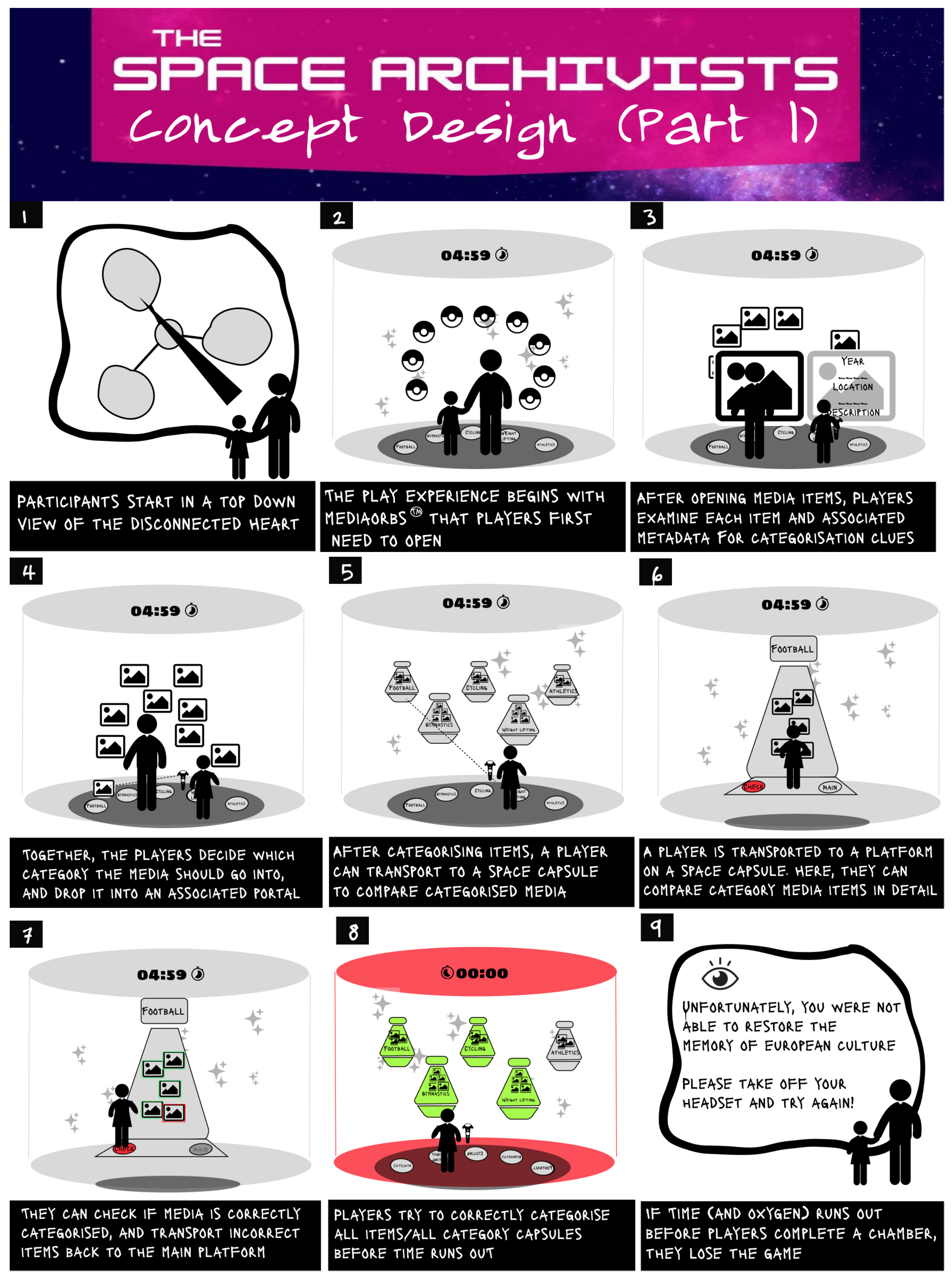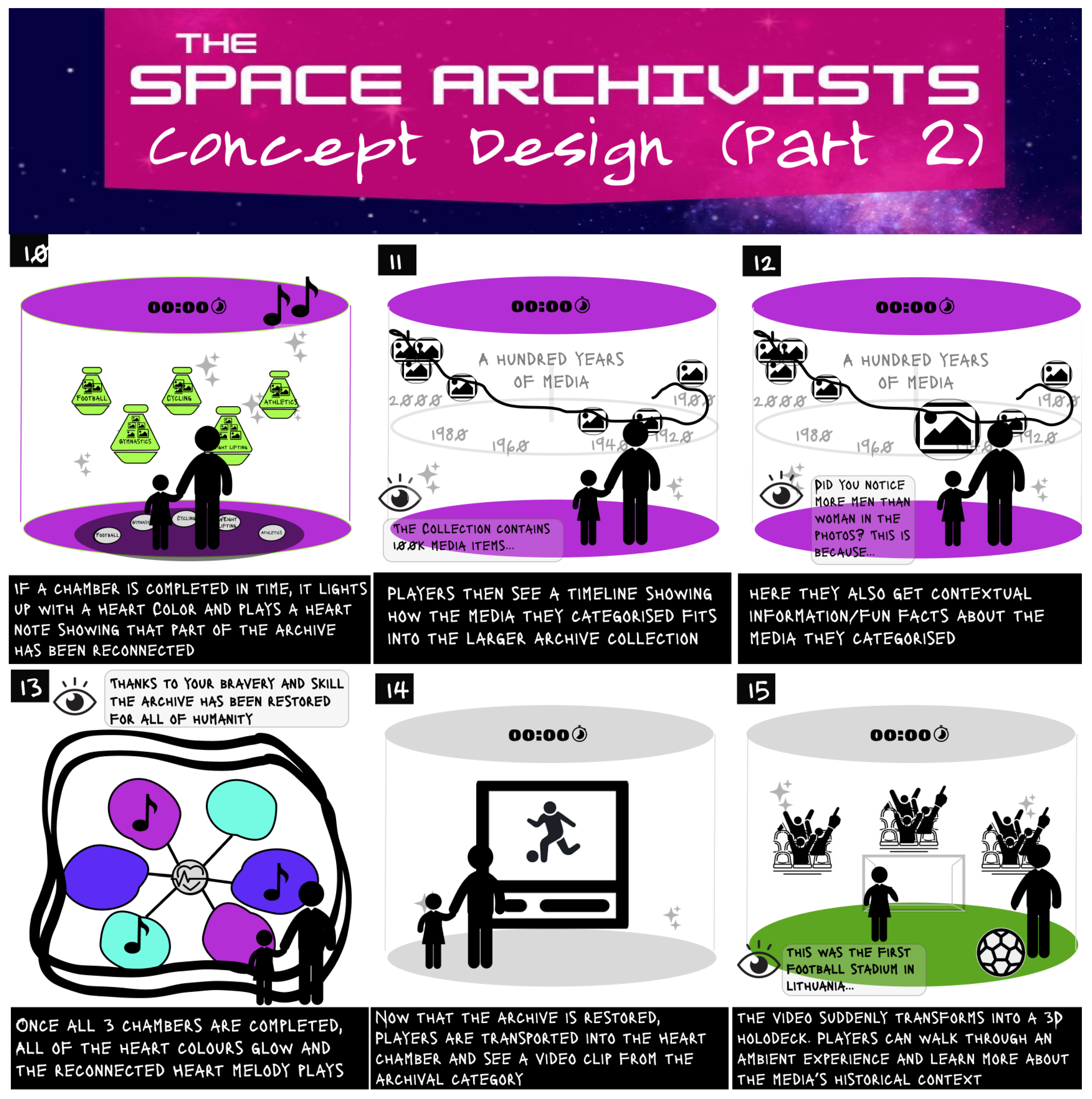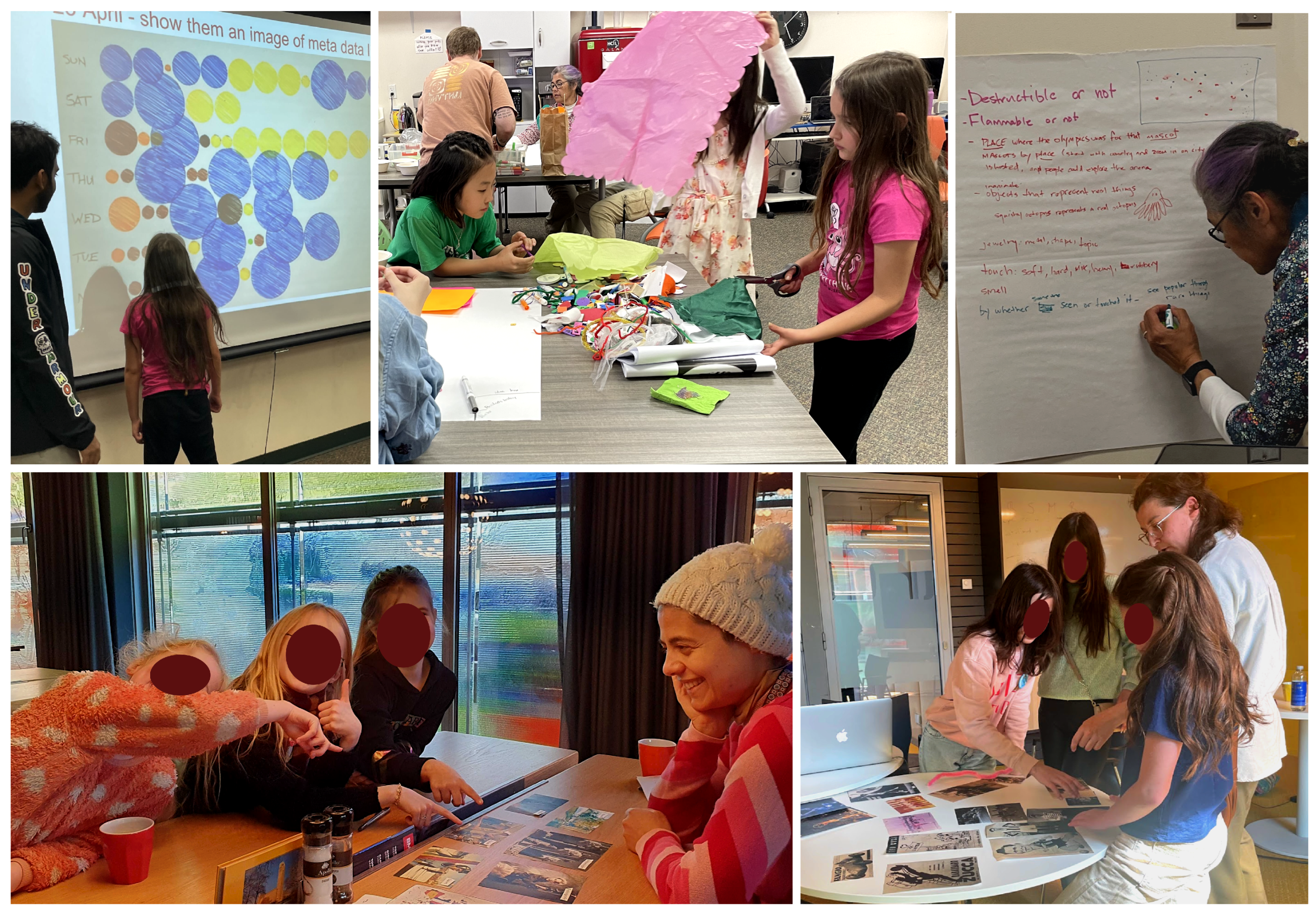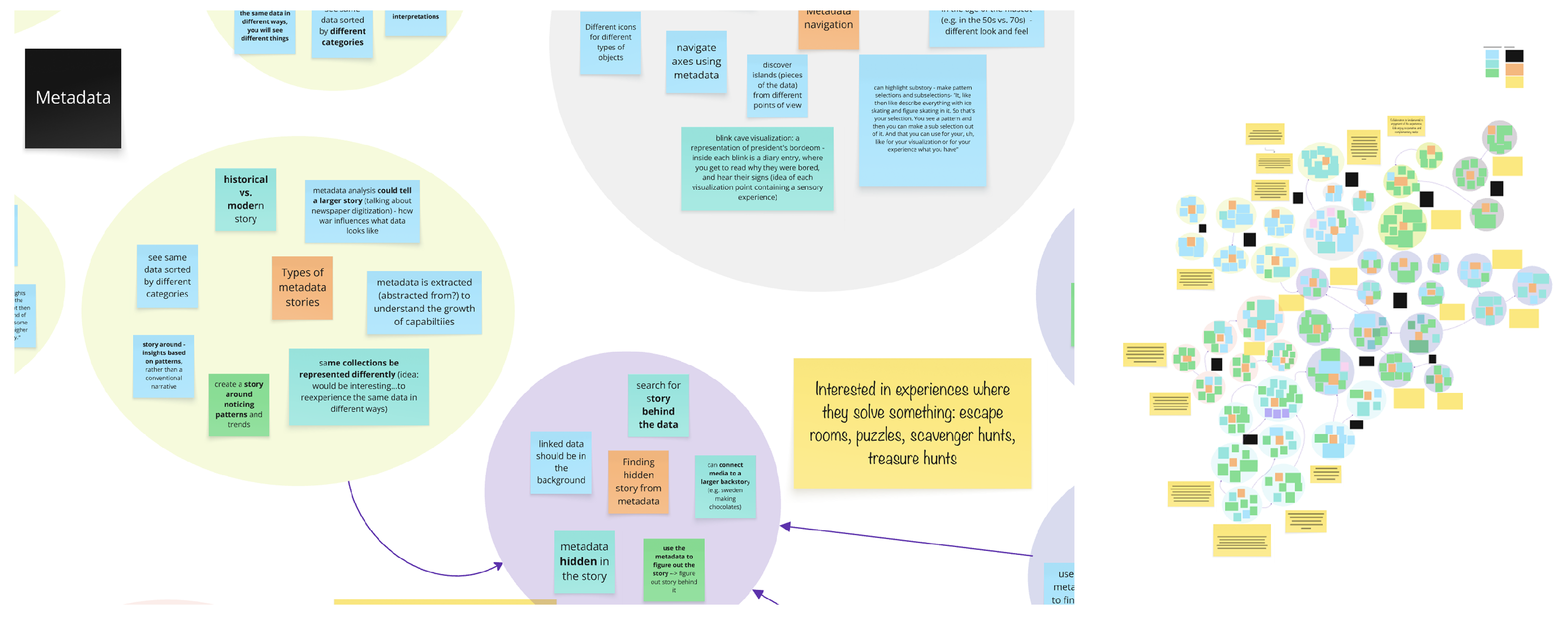Designing the Space Archivists: A Metadata-Driven VR Game Concept for Children to Engage with Cultural Heritage
Abstract
1. Introduction
2. Related Work
2.1. Designing Immersive Experiences for Cultural Heritage
2.2. Children Engaging with VR
2.3. Children Designing with Data in Cultural Heritage
2.4. Research Question and Design Challenge
3. Method
3.1. Design Salon with Data Professionals
3.2. Child Participatory Design Workshops on Data
3.3. Child Participatory Design Workshops on Media
3.4. Data Analysis
4. Results
4.1. Theme 1: Expert-Described Metadata Challenges and Value for Storytelling
4.2. Theme 2: Child Interpretations of Abstract Data
4.3. Theme 3: Immersive and Collaborative Learning Contexts
4.4. Theme 4: Exploring Media Diversity Through Categorisation Games
5. The Space Archivists: Helping Children Connect to Historical and Contextual Details
6. Discussion
6.1. Limitations
6.2. Design Insights
6.2.1. Considering the Contextual Complexity of Data and Audience Needs
6.2.2. Connecting Data Abstractions to Embodied Narratives Through Categorisation Mechanics
6.2.3. Supporting Abstract Meaning Making Using the Immersive Affordances of VR
7. Conclusions and Future Work
Author Contributions
Funding
Institutional Review Board Statement
Informed Consent Statement
Data Availability Statement
Conflicts of Interest
Abbreviations
| PD | Participatory Design |
| CHI | Cultural Heritage Institution |
| VR | Virtual Reality |
| CI | Cooperative Inquiry |
Appendix A. Detailed Description of Concept Design
“It’s the end of the earth and all that’s left of the original human race is an archive sent to space. While functional, the archive pulses; it’s alive, preserving the memory of humankind, bringing life to the new generation of humanity spread out across the planets. But oh no! a meteorite has damaged the archive, knocking the images around. You are a team of space archivists from the future, brought together to save the archive, and humanity! Together with your partner, can you bring the archive back online by organising the media with your background knowledge and observation skills?”


Appendix B. Initial Themes and Design Insights
| Theme | Sub-Theme | Code | Design Insights |
|---|---|---|---|
| Theme 1 | Metadata Goals and Values | (1) Metadata Values and Goals, (2) Data Story Process, (3) Broken and Biased Metadata, (4) Metadata Can be Interpreted Differently | Archival metadata has a lot of bias and does not make sense on its own. Creating a good experience means (1) having a clear goal, (2) being selective, and (3) integrating it with the material. |
| Theme 1 | Metadata in Storytelling | (1) Metadata Navigation, (2) Finding Hidden Story from Metadata, (3) Metadata Representation in Puzzles | (a) Metadata has different layers of meaning and can be interpreted and represented in different ways. Metadata stories can be about (1) telling a higher-level story about media or (2) about what happens when representing the same collection in different ways. (b) Metadata experience can be in the background of the experience, either as a hidden form of organisation, or a visible experience goal. |
| Theme 2 | Data Scaffolding | (1) Abstract vs. Concrete Scaffolding | Creating a concrete-to-abstract scaffold is essential in having children understand data; they need to first see the concrete representation of the abstract representation, then see the abstract form (e.g., see a picture of their favourite football player before seeing how many media items there are about them). |
| Theme 3 | Motivation | (1) Personal Motivation, (2) What is Boring, (3) Experience Goals | Children are motivated by feeling smart; they want feedback that they know things (e.g., facts) and want gamified learning experiences. |
| Theme 3 | Collaboration | (1) Working Together is Fun, (2) Collaborative Experience, (3) Separate Journeys | (a) Collaboration is fundamental to the enjoyment of the experience; kids enjoy cooperative and complementary tasks. (b) Collaboration can happen through separate journeys, where children can solve puzzles independently, then come together to solve a final puzzle. |
| Theme 4 | Game Mechanics | (1) Puzzle Games, (2) Curated vs. Free Exploration, (3) Scavenger hunt, (4) Multi-layer Games | (a) Children are interested in experiences where they solve something: escape rooms, puzzles, scavenger and treasure hunts, choose your own adventure games. (b) The experience can have a multi-layer dynamic, with games being used to open up other games, games within games, or several puzzles or mini-games leading to a final puzzle or reward. |
| Theme 4 | Categorisation | (1) Categorisation as a Goal, (2) Tagging Interaction, (3) Type of Photo (Live, Posed, Action), (4) Binary Categories, (5) Black and White vs. Color Categories, (6) Biased Categorisation, (7) Types of Categories, (8) Categorisation by Clothes | (a) Children categorised data into a number of concrete properties: colour, shape, weight (for physical objects), clothing, number of people, sport, number of boys/girls, faces, and emotion. They also categorised images by type of photo (live, posed, or action) and whether the image is in colour. (b) Children have categorisation bias: some categorise by background knowledge (e.g., knowing a sports team’s colours), while others are confused by B&W photos. Also, images that are harder to understand are less interesting to children (e.g., an advertisement in another language), so they pay less attention to those. |
| 1 | While VR has potential to be a transformative technology across disciplines, concerns about potential risks for children remain. Our work is part of a larger effort to ethically and thoughtfully explore how the rapidly expanding development of VR systems can support children in CHI contexts [62,63]. |
| 2 | As children are a vulnerable demographic, particular attention was paid to ensure their participation was consensual; both parents and children signed a consent form prior to participating, and children’s consent forms were written in child-friendly language to make them easy to understand. Further, children were told several times that they could stop participating at any time. |
| 3 | ‘F’ refers to quotes from facilitators reflecting on the experiences they saw, as child explanations were not always clear. |
| 4 | We will have media items with different levels of categorisation difficulty. As players will be of different ages and will include parents as well as children, players will be able to choose from easy, medium, and hard modes with different types of media. |
| 5 | For instance, a fun fact could point out that there are far fewer female athletes in the Europeana Sport dataset because fewer women competed in sports at the beginning of the twentieth century. |
References
- Reimat, I.; Mei, Y.; Alexiou, E.; Jansen, J.; Li, J.; Subramanyam, S.; Viola, I.; Oomen, J.; Cesar, P. Mediascape XR: A Cultural Heritage Experience in Social VR. In Proceedings of the 30th ACM International Conference on Multimedia (MM ’22), Lisboa, Portugal, 10–14 October 2022. [Google Scholar] [CrossRef]
- Cecotti, H. Cultural Heritage in Fully Immersive Virtual Reality. Virtual Worlds 2022, 1, 82–102. [Google Scholar] [CrossRef]
- Iacono, S.; Scaramuzzino, M.; Martini, L.; Panelli, C.; Zolezzi, D.; Perotti, M.; Traverso, A.; Vercelli, G.V. Virtual Reality in Cultural Heritage: A Setup for Balzi Rossi Museum. Appl. Sci. 2024, 14, 3562. [Google Scholar] [CrossRef]
- Münster, S.; Maiwald, F.; Bruschke, J.; Kröber, C.; Sun, Y.; Dworak, D.; Komorowicz, D.; Munir, I.; Beck, C.; Münster, D.L. A digital 4D information system on the world scale: Research challenges, approaches, and preliminary results. Appl. Sci. 2024, 14, 1992. [Google Scholar] [CrossRef]
- Spence, J.; Darzentas, D.P.; Huang, Y.; Cameron, H.R.; Beestin, E.; Benford, S. VRtefacts: Performative Substitutional Reality with Museum Objects. In Proceedings of the 2020 ACM Designing Interactive Systems Conference DIS ’20, Eindhoven, The Netherlands, 6–10 July 2020; pp. 627–640. [Google Scholar] [CrossRef]
- 5Dculture. Iberian Culture Unveiled Through 3D Models. Available online: https://5dculture.eu/scenario/archaeology/iberian-culture (accessed on 4 June 2025).
- Unlimited Van Abbe. Van Abbemuseum—Museum voor Hedendaagse Kunst—Eindhoven. Available online: https://vanabbemuseum.nl/en/collection-research/research/search-in-research/special-guests-onbeperkt-van-abbe-unlimited-van-abbeonvergetelijk-multizintuigelijk-spraakmakend-open-je-hart (accessed on 4 June 2025).
- 5Dculture. Available online: https://5dculture.eu/scenario/fashion/social-vr (accessed on 4 June 2025).
- Whitelaw, M. Visualising archival collections: The visible archive project. Arch. Manuscripts 2009, 37, 22–40. [Google Scholar]
- Kenderdine, S. Experimental Museology as Big Data. In Museums and Exhibitions After New Media; Achiam, M., Haldrup, M., Drotner, K., Eds.; Taylor & Francis: Abingdon, UK, 2019; pp. 3–22. [Google Scholar] [CrossRef]
- Hawkins, A. Archives, linked data and the digital humanities: Increasing access to digitised and born-digital archives via the semantic web. Arch. Sci. 2022, 22, 319–344. [Google Scholar] [CrossRef]
- Whitelaw, M. Generous Interfaces for Digital Cultural Collections. Digit. Humanit. Q. 2015, 9, 1–22. [Google Scholar]
- Davis, S.B.; Vane, O.; Kräutli, F. Using Data Visualisation to tell Stories about Collections. In Electronic Visualisation and the Arts (EVA); BCS Learning & Development: London, UK, 2016. [Google Scholar]
- Bilstrup, K.E.K.; Kaspersen, M.H.; Lunding, M.S.; Schaper, M.M.; Van Mechelen, M.; Tamashiro, M.A.; Smith, R.C.; Iversen, O.S.; Petersen, M.G. Supporting critical data literacy in K-9 education: Three principles for enriching pupils’ relationship to data. In Proceedings of the 21st Annual ACM Interaction Design and Children Conference, New York, NY, USA, 27–30 June 2022; pp. 225–236. [Google Scholar]
- Masson, E.; Olesen, C.G.; van Noord, N.; Fossati, G. Exploring Digitised Moving Image Collections: The SEMIA Project, Visual Analysis and the Turn to Abstraction. Digit. Humanit. Q. 2020, 14, 1–14. [Google Scholar]
- Masson, E.; Olesen, C.G. Digital Access as Archival Reconstitution: Algorithmic Sampling, Visualization, and the Production of Meaning in Large Moving Image Repositories. Signata 2021, 12. [Google Scholar] [CrossRef]
- Furuta, S.M.; Salamanca, A.R.; Odd, M.; Stork, L.; Weber, A. Herbaria Heritage: Visualising Colonial Bias in Natural History Collections. Available online: https://research.utwente.nl/files/481046060/Furuta_et_al_2025_Herbaria_Heritage_Visualising_Colonial_Bias_in_Natural_History_Collections.pdf (accessed on 4 June 2025).
- Sula, C.A. Quantifying Culture: The Value of Visualization inside (and outside) Libraries, Museums, and the Academy. In Proceedings of the EVA 2012, London, UK, 10–12 July 2012; pp. 123–130. [Google Scholar] [CrossRef]
- Innocente, C.; Ulrich, L.; Moos, S.; Vezzetti, E. A framework study on the use of immersive XR technologies in the cultural heritage domain. J. Cult. Herit. 2023, 62, 268–283. [Google Scholar] [CrossRef]
- Zhang, Y.; Keighrey, C.; Murray, N. A VR intervention based on social story™ to develop social skills in children with ASD. In Proceedings of the 2023 ACM International Conference on Interactive Media Experiences, Nantes, France, 12–15 June 2023; pp. 205–208. [Google Scholar]
- Su, X.; Yan, S. NoPhobiar: Designing A VR Game to Prevent Childhood Dark Phobia with Children and Stakeholders. In Proceedings of the Extended Abstracts of the 2023 CHI Conference on Human Factors in Computing Systems, Hamburg, Germany, 23—28 April 2023; pp. 1–6. [Google Scholar]
- Muravevskaia, E. Empathy development in young children using interactive VR games. In Proceedings of the Annual Symposium on Computer-Human Interaction in Play, Amsterdam, The Netherlands, 15–18 October 2017; pp. 715–718. [Google Scholar]
- Ma, L.; Yu, Q.; Huang, J.; Sun, Y. Based on the Exploration of VR in the Teaching and Training of Special Children. In Proceedings of the 2022 3rd International Conference on Education Development and Studies, Hilo, HI, USA, 9–11 March 2022; pp. 37–41. [Google Scholar]
- Delgado, J.; West, R.; Barmpoutis, A.; Jang, S.H.; Stanley, E.; Kang, H. Enhancing Museum Experience with VR by Situating 3D Collections in Contex. In Proceedings of the 23rd Annual ACM Interaction Design and Children Conference, Delft, The Netherlands, 17–20 June 2024; pp. 670–675. [Google Scholar]
- Chu, Y. The application of vr technology in traditional culture and art immersive teaching for chinese children. In Proceedings of the 13th International Conference on Education Technology and Computers, Wuhan, China, 22–25 October 2021; pp. 99–104. [Google Scholar]
- Piaget, J. Jean Piaget; Clark University Press: Worcester, MA, USA, 1952. [Google Scholar]
- Kolb, D.A. Experiential Learning: Experience as the Source of Learning and Development; FT Press: Upper Saddle River, NJ, USA, 2014. [Google Scholar]
- Rau, M.A. Conditions for the effectiveness of multiple visual representations in enhancing STEM learning. Educ. Psychol. Rev. 2017, 29, 717–761. [Google Scholar] [CrossRef]
- Wilensky, U. Abstract Meditations on the Concrete and Concrete Implications for Mathematics Education. In Constructionism; Ablex Publishing Corp.: Norwood, NJ, USA, 1991. [Google Scholar]
- Clements, D.H. ‘Concrete’ manipulatives, concrete ideas. Contemp. Issues Early Child. 2000, 1, 45–60. [Google Scholar] [CrossRef]
- English, L.D. Young children’s early modelling with data. Math. Educ. Res. J. 2010, 22, 24–47. [Google Scholar] [CrossRef]
- Alper, B.; Riche, N.H.; Chevalier, F.; Boy, J.; Sezgin, M. Visualization literacy at elementary school. In Proceedings of the 2017 CHI Conference on Human Factors in Computing Systems, Denver, CO, USA, 6–11 May 2017; pp. 5485–5497. [Google Scholar]
- Turkle, S.; Papert, S. Epistemological pluralism: Styles and voices within the computer culture. Signs J. Women Cult. Soc. 1990, 16, 128–157. [Google Scholar] [CrossRef]
- Picard, R.W.; Papert, S.; Bender, W.; Blumberg, B.; Breazeal, C.; Cavallo, D.; Machover, T.; Resnick, M.; Roy, D.; Strohecker, C. Affective learning—A manifesto. BT Technol. J. 2004, 22, 253–269. [Google Scholar] [CrossRef]
- Ben-Zvi, D.; Aridor-Berger, K. Children’s wonder how to wander between data and context. The Teaching and Learning of Statistics: International Perspectives; Springer: Cham, Switzerland, 2016; pp. 25–36. [Google Scholar]
- Fails, J.A.; Pera, M.S.; Anuyah, O.; Kennington, C.; Wright, K.L.; Bigirimana, W. Query formulation assistance for kids: What is available, when to help & what kids want. In Proceedings of the 18th ACM international Conference on Interaction Design and Children, Boise, ID, USA, 12–15 June 2019; pp. 109–120. [Google Scholar]
- Bettencourt, B.J.; Pera, M.S.; Kennington, C.; Wright, K.L.; Fails, J.A. Kid Query: Co-designing an Application to Scaffold Query Formulation. In Proceedings of the 23rd Annual ACM Interaction Design and Children Conference, Delft, The Netherlands, 17–20 June 2024; pp. 828–833. [Google Scholar]
- Gossen, T.; Hempel, J.; Nürnberger, A. Find it if you can: Usability case study of search engines for young users. Pers. Ubiquitous Comput. 2013, 17, 1593–1603. [Google Scholar] [CrossRef]
- Reuter, K. Assessing aesthetic relevance: Children’s book selection in a digital library. J. Am. Soc. Inf. Sci. Technol. 2007, 58, 1745–1763. [Google Scholar] [CrossRef]
- Reuter, K.; Druin, A. Bringing together children and books: An initial descriptive study of children’s book searching and selection behavior in a digital library. Proc. Am. Soc. Inf. Sci. Technol. 2004, 41, 339–348. [Google Scholar] [CrossRef]
- Baek, J.S.; Lee, K.P. A participatory design approach to information architecture design for children. Co-Design 2008, 4, 173–191. [Google Scholar] [CrossRef]
- Pejtersen, A.M. Design and test of a database for fiction, based on an analysis of children’s search behavior. In Information Technology and Information Use: Towards a Unified View of Information and Information Technology; Taylor Graham Publishing: London, UK, 1986; pp. 125–146. [Google Scholar]
- Druin, A. What children can teach us: Developing digital libraries for children with children. Libr. Q. 2005, 75, 20–41. [Google Scholar] [CrossRef]
- Cooper, L.Z. A case study of information-seeking behavior in 7-year-old children in a semistructured situation. J. Am. Soc. Inf. Sci. Technol. 2002, 53, 904–922. [Google Scholar] [CrossRef]
- Sinclair, N. The aesthetic “is" relevant. Learn. Math. 2001, 21, 25–32. [Google Scholar]
- Druin, A.; Bederson, B.B.; Hourcade, J.P.; Sherman, L.; Revelle, G.; Platner, M.; Weng, S. Designing a digital library for young children. In Proceedings of the 1st ACM/IEEE-CS Joint Conference on Digital Libraries, Roanoke, VA, USA, 24–28 June 2001; pp. 398–405. [Google Scholar]
- Simon, N. The Participatory Museum. AK Peters: Natick, MA, USA, 2010. [Google Scholar]
- Culén, A.L.; Bratteteig, T.; Pandey, S.; Srivastava, S. The child-to-child (C2C) method: Participatory design for, with and by children in a children’s museum. IADIS Int. J. 2013, 11, 92–113. [Google Scholar]
- TaxÉn, G.; Druin, A.; Fast, C.; Kjellin, M. KidStory: A technology design partnership with children. Behav. Inf. Technol. 2001, 20, 119–125. [Google Scholar] [CrossRef]
- Axelsen, L.V.; Mygind, L.; Bentsen, P. Designing with children: A participatory design framework for developing interactive exhibitions. Int. J. Incl. Mus. 2014, 7, 1. [Google Scholar] [CrossRef]
- Arrigoni, G.; Schofield, T.; Trujillo Pisanty, D. Framing collaborative processes of digital transformation in cultural organisations: From literary archives to augmented reality. Mus. Manag. Curatorship 2020, 35, 424–445. [Google Scholar] [CrossRef]
- Schofield, T.; Trujillo Pisanty, D.; Arrigoni, G.; Reynolds, K.; Pattinson, R. Magical realism and augmented reality: Designing apps with children in a cultural institution. In Proceedings of the 2019 on Designing Interactive Systems Conference, San Diego, CA, USA, 23–28 June 2019; pp. 737–749. [Google Scholar]
- Dindler, C.; Iversen, O.S.; Smith, R.; Veerasawmy, R. Participatory design at the museum: Inquiring into children’s everyday engagement in cultural heritage. In Proceedings of the 22nd Conference of the Computer-Human Interaction Special Interest Group of Australia on Computer-Human Interaction, Brisbane, Australia, 22–26 November 2010; pp. 72–79. [Google Scholar]
- Iversen, O.S.; Smith, R.C. Scandinavian participatory design: Dialogic curation with teenagers. In Proceedings of the 11th International Conference on Interaction Design and Children, Bremen, Germany, 12–15 June 2012; pp. 106–115. [Google Scholar]
- Roussou, M.; Kavalieratou, E.; Doulgeridis, M. Children designers in the museum: Applying participatory design for the development of an art education program. In Proceedings of the 6th International Conference on Interaction Design and Children, Aalborg, Denmark, 6–8 June 2007; pp. 77–80. [Google Scholar]
- Nesset, V.; Large, A. Children in the information technology design process: A review of theories and their applications. Libr. Inf. Sci. Res. 2004, 26, 140–161. [Google Scholar] [CrossRef]
- Druin, A. Cooperative inquiry: Developing new technologies for children with children. In Proceedings of the SIGCHI Conference on Human Factors in Computing Systems, Pittsburgh, PA, USA, 15–20 May 1999; pp. 592–599. [Google Scholar]
- Cowan, N.; Fristoe, N.M.; Elliott, E.M.; Brunner, R.P.; Saults, J.S. Scope of attention, control of attention, and intelligence in children and adults. Mem. Cogn. 2006, 34, 1754–1768. [Google Scholar] [CrossRef]
- Hourcade, J.P. Child-Computer Interaction; University of Iowa: Iowa City, IA, USA, 2015. [Google Scholar]
- Yip, J.; Clegg, T.; Bonsignore, E.; Gelderblom, H.; Rhodes, E.; Druin, A. Brownies or bags-of-stuff? Domain expertise in cooperative inquiry with children. In Proceedings of the 12th International Conference on Interaction Design and Children, New York, NY, USA, 24–27 June 2013; pp. 201–210. [Google Scholar]
- Windhager, F.; Federico, P.; Schreder, G.; Glinka, K.; Dörk, M.; Miksch, S.; Mayr, E. Visualization of Cultural Heritage Collection Data: State of the Art and Future Challenges. IEEE Trans. Vis. Comput. Graph. 2019, 25, 2311–2330. [Google Scholar] [CrossRef]
- Hourcade, J.P.; Schmuecker, S.; Norris, D.; Currin, F.H. Understanding Adult Stakeholder Perspectives on the Ethics of Extended Reality Technologies with a Focus on Young Children and Children in Rural Areas. In Proceedings of the 23rd Annual ACM Interaction Design and Children Conference, Delft, The Netherlands, 17–20 June 2024; pp. 455–468. [Google Scholar] [CrossRef]
- Jin, Q.; Kawas, S.; Arora, S.; Yuan, Y.; Yarosh, S. Is Your Family Ready for VR? Ethical Concerns and Considerations in Children’s VR Usage. In Proceedings of the 23rd Annual ACM Interaction Design and Children Conference, Delft, The Netherlands, 17–20 June 2024; pp. 436–454. [Google Scholar] [CrossRef]
- Leminen, S.; Westerlund, M.; Nyström, A.G. On becoming creative consumers–user roles in living labs networks. Int. J. Technol. Mark. 2014, 9, 33–52. [Google Scholar] [CrossRef]
- Ballon, P.; Pierson, J.; Delaere, S. Test and Experimentation Platforms for Broadband Innovation: Examining European Practice. SSRN 1331557. 2005. Available online: https://papers.ssrn.com/sol3/papers.cfm?abstract_id=1331557 (accessed on 1 April 2025).
- Guha, M.L.; Druin, A.; Fails, J.A. Cooperative Inquiry Revisited. In Action Research: Models, Methods, and Examples; Information Age Publishing: Charlotte, NC, USA, 2014; p. 269. [Google Scholar]
- Wells, P. The “dear data” project: More than just data-art. Morning Watch. Educ. Soc. Anal. 2018, 45, 1–15. [Google Scholar]
- Europeana Sport. 2024. Available online: https://pro.europeana.eu/project/europeana-sport (accessed on 4 June 2025).
- Braun, V.; Clarke, V. Using thematic analysis in psychology. Qual. Res. Psychol. 2006, 3, 77–101. [Google Scholar] [CrossRef]
- Maguire, M.; Delahunt, B. Doing a thematic analysis: A practical, step-by-step guide for learning and teaching scholars. All Irel. J. High. Educ. 2017, 9. [Google Scholar]
- Weber, W.; Engebretsen, M.; Kennedy, H. Data stories: Rethinking journalistic storytelling in the context of data journalism. Stud. Commun. Sci. 2018, 2018, 191–206. [Google Scholar] [CrossRef]
- Nofal, E.; Panagiotidou, G.; Reffat, R.M.; Hameeuw, H.; Boschloos, V.; Vande Moere, A. Situated tangible gamification of heritage for supporting collaborative learning of young museum visitors. J. Comput. Cult. Herit. 2020, 13, 1–24. [Google Scholar] [CrossRef]
- Berger, J. Ways of Seeing; Penguin UK: London, UK, 2008. [Google Scholar]
- Kizhner, I.; Terras, M.; Rumyantsev, M.; Khokhlova, V.; Demeshkova, E.; Rudov, I.; Afanasieva, J. Digital cultural colonialism: Measuring bias in aggregated digitized content held in Google Arts and Culture. Digit. Scholarsh. Humanit. 2021, 36, 607–640. [Google Scholar] [CrossRef]
- Striner, A.G. Simulating Reality: Training Citizen Scientists to Judge Stream Habitats in Multisensory Virtual Reality. Ph.D. Thesis, University of Maryland, College Park, MD, USA, 2019. [Google Scholar]
- Csikszentmihalyi, M. Intrinsic motivation in museums: Why does one want to learn. In Public Institutions for Personal Learning: Establishing a Research Agenda; American Association of Museums, Technical Information Service: Washington, DC, USA, 1995. [Google Scholar]
- Buchanan, R. Wicked problems in design thinking. Des. Issues 1992, 8, 5–21. [Google Scholar] [CrossRef]
- Alavi, H.S.; Lalanne, D.; Rogers, Y. The five strands of living lab: A literature study of the evolution of living lab concepts in HCI. ACM Trans. Comput.-Hum. Interact. 2020, 27, 1–26. [Google Scholar] [CrossRef]



Disclaimer/Publisher’s Note: The statements, opinions and data contained in all publications are solely those of the individual author(s) and contributor(s) and not of MDPI and/or the editor(s). MDPI and/or the editor(s) disclaim responsibility for any injury to people or property resulting from any ideas, methods, instructions or products referred to in the content. |
© 2025 by the authors. Licensee MDPI, Basel, Switzerland. This article is an open access article distributed under the terms and conditions of the Creative Commons Attribution (CC BY) license (https://creativecommons.org/licenses/by/4.0/).
Share and Cite
Goldman, A.; Bocyte, R.; Blinder, E.B.; Verhofstadt, A.; Bonsignore, E.; Cesar, P. Designing the Space Archivists: A Metadata-Driven VR Game Concept for Children to Engage with Cultural Heritage. Heritage 2025, 8, 238. https://doi.org/10.3390/heritage8070238
Goldman A, Bocyte R, Blinder EB, Verhofstadt A, Bonsignore E, Cesar P. Designing the Space Archivists: A Metadata-Driven VR Game Concept for Children to Engage with Cultural Heritage. Heritage. 2025; 8(7):238. https://doi.org/10.3390/heritage8070238
Chicago/Turabian StyleGoldman, Alina, Rasa Bocyte, Elana B. Blinder, Arno Verhofstadt, Elizabeth Bonsignore, and Pablo Cesar. 2025. "Designing the Space Archivists: A Metadata-Driven VR Game Concept for Children to Engage with Cultural Heritage" Heritage 8, no. 7: 238. https://doi.org/10.3390/heritage8070238
APA StyleGoldman, A., Bocyte, R., Blinder, E. B., Verhofstadt, A., Bonsignore, E., & Cesar, P. (2025). Designing the Space Archivists: A Metadata-Driven VR Game Concept for Children to Engage with Cultural Heritage. Heritage, 8(7), 238. https://doi.org/10.3390/heritage8070238









